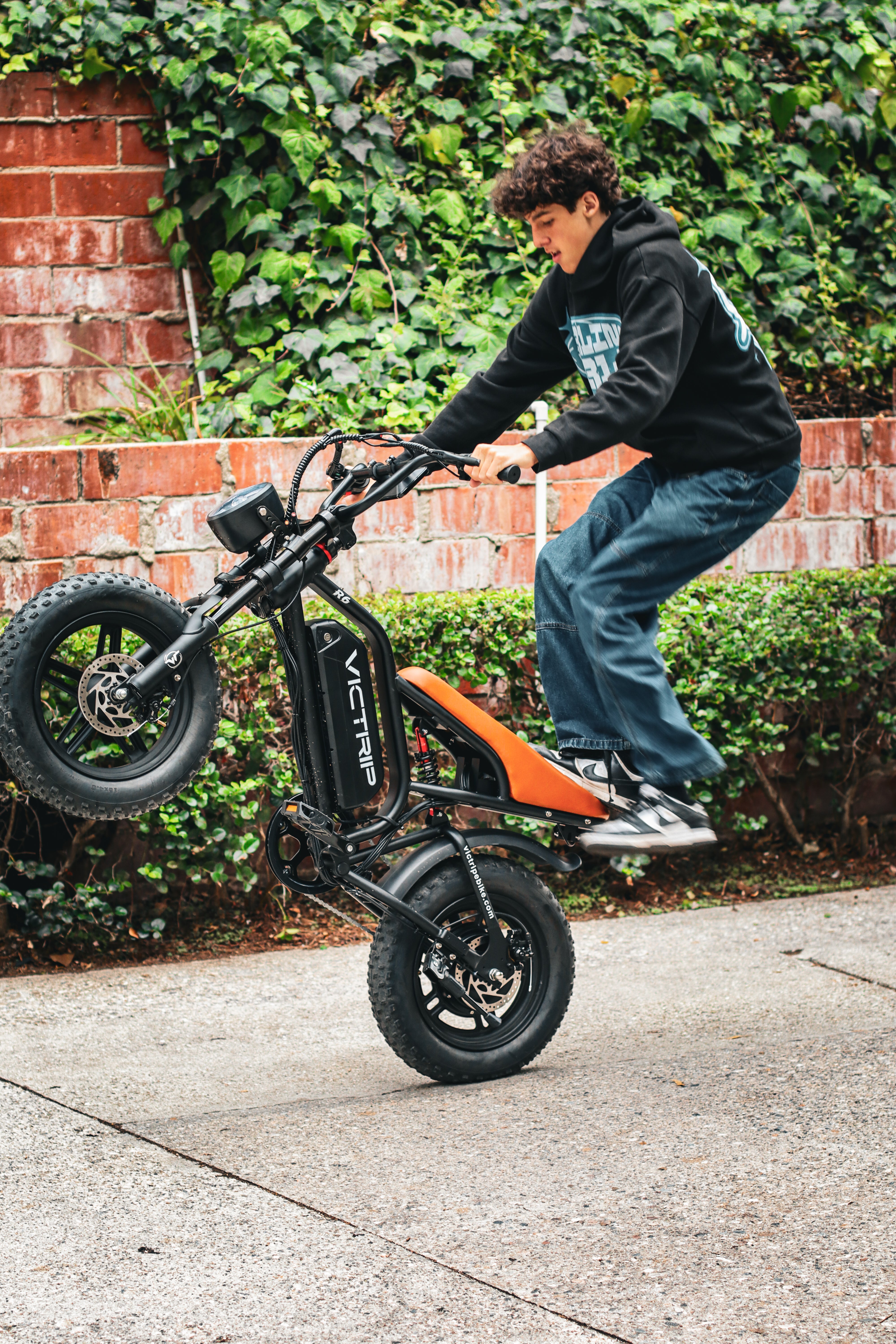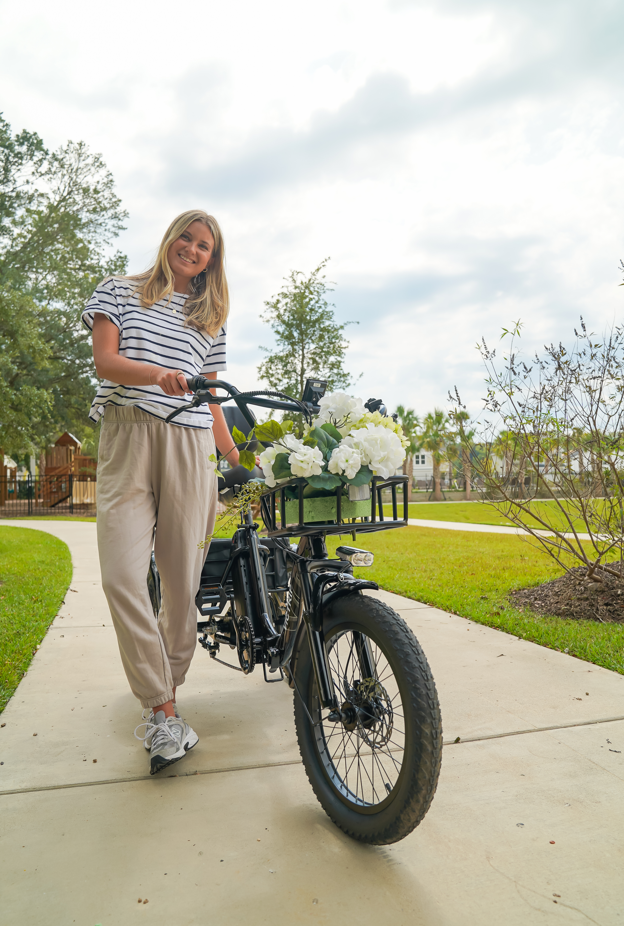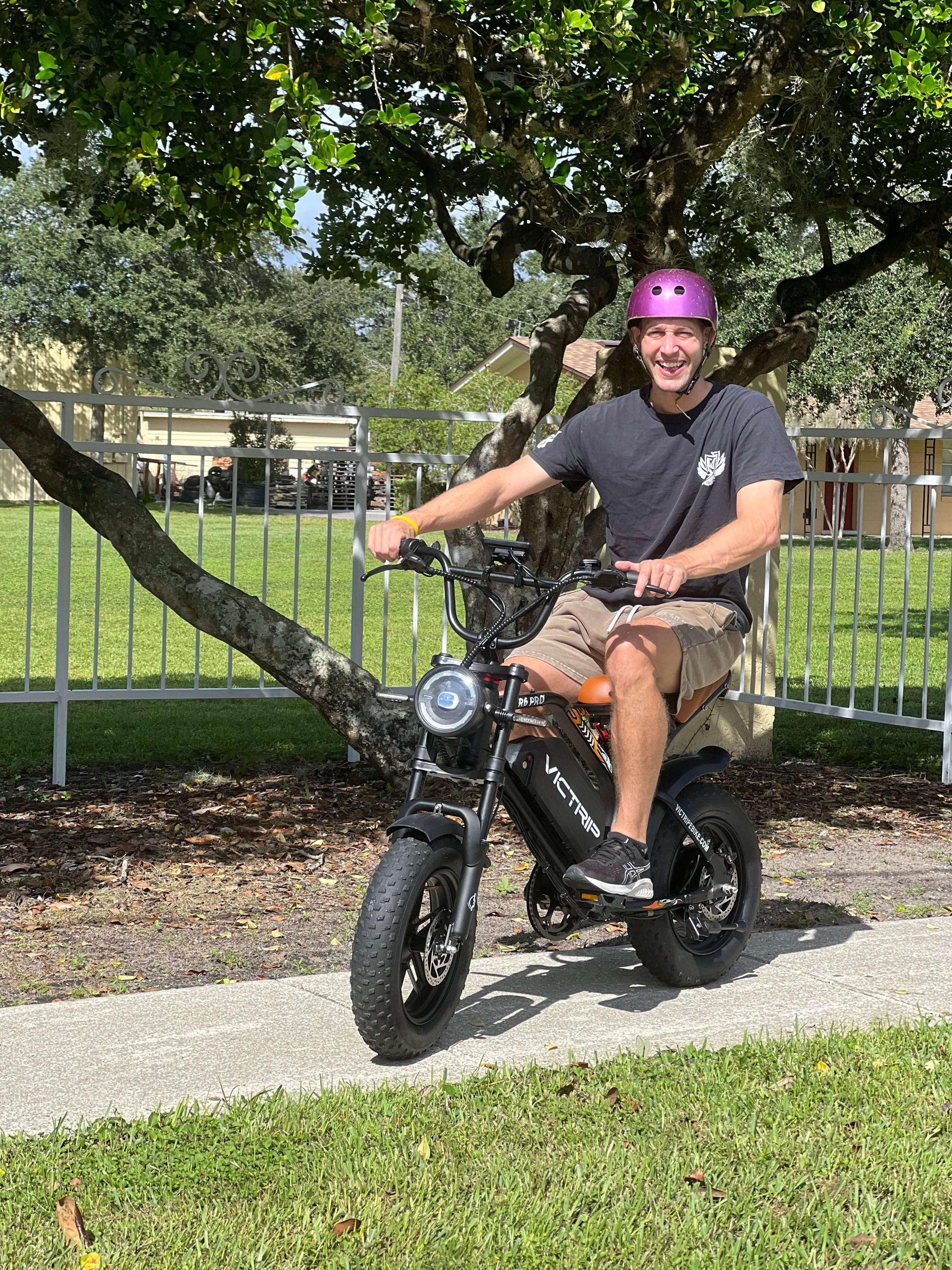Can Mobility Scooters Be Replaced by Three-Wheel Electric Bikes? Millions of people's mobility decisions influence their level of independence, so that question is important. In summary, 3 wheel electric bikes can occasionally—and in many everyday situations—replace mobility scooters, though the suitability varies depending on the individual, the setting, and local regulations. In order to help you determine whether a three-wheeled e-bike is the best option for replacing a mobility scooter in your particular situation, this article examines the available data in the areas of design, safety, cost, regulation, and lived experience.
We will discuss how the stability, maneuverability, comfort, range, cost, and social aspects of three-wheeled e-bikes compare to those of traditional mobility scooters. There are at least six frequently asked questions, a useful comparison table, and a candid recommendation based on usability and practical tradeoffs. Helping clinicians, caregivers, and potential purchasers make the most informed choice possible is the aim.
Design & Mobility Comparison
Stability: Three wheels vs scooter base
Three wheel electric bikes are often designed with either two wheels in front and one in back (tadpole) or one in front and two in back (delta). Mobility scooters usually have a four-wheel or three-wheel configuration, with a low platform and upright seat. Stability depends on center of gravity, wheelbase, and suspension. 3 Wheel e-bikes tend to have a higher center of gravity because of bicycle-like frames and seating positions; some models mitigate this with wide wheel tracks and low battery placement. Scooters typically place the user lower and closer to the wheelbase center, giving inherent steadiness at low speeds and when stationary.
The VICTRIP T1 is a prime example of how modern engineering can deliver both comfort and control. Its extended rear axle and low-mounted lithium battery help distribute weight evenly, offering enhanced stability even when carrying heavier loads or riding on uneven terrain.

Maneuverability & footprint
Maneuverability is where many 3 Wheel e-bikes shine. Bikes are built to turn, lean slightly, and navigate obstacles on roadways. Their turning radius is often smaller than that of full-sized mobility scooters, especially the long-chassis models used for heavy loads. That makes 3 Wheel e-bikes excellent in mixed traffic, on bike lanes, or on narrow sidewalks where you need nimble responses. At the same time, scooters were built for indoor use — shopping malls, medical centers, and tight store aisles — so their design prioritizes extremely tight turning and slow-speed control.
If your primary use is indoors or within crowded retail spaces, a mobility scooter might serve better. If you plan to travel longer distances, ride on bike lanes, or need a vehicle that can cross curbs and uneven surfaces, a 3 Wheel e-bike often offers better versatility.
Comfort & seating
Comfort matters for long outings. Scooter seats typically have more padding, higher backs, and armrests, which keep users comfortable during long, slow trips. 3 Wheel e-bikes tend to use bicycle-style seats or cruiser seats; high-end models offer ergonomic, cushioned chairs with suspension seats and back support. Handlebar position, seat height, and foot placement differ: bikes demand a slightly more engaged posture, while scooters encourage upright, passive riding.
For users with chronic pain or limited trunk control, scooter seats can be easier to get in and out of. However, modern 3 Wheel e-bikes can match or exceed seating comfort if they’re designed for mobility users — but that usually adds to cost.
Accessibility & transfers
Transfers (moving from wheelchair to seat) are critical. Scooters often allow side transfers because of a low seat and simple frame. Many 3 Wheel e-bikes still require stepping over a crossbar, though step-through frames and adaptive seats are becoming more common. For people who transfer frequently, look for bikes with low-step frames, removable armrests, or swivel seats. Without these, replacing a scooter with a bike may not be practical.
Terrain & weather performance
Scooters perform best on flat, paved surfaces. Their small wheels and limited suspension make grass, loose gravel, or steep ramps problematic. 3 Wheel e-bikes, with larger wheels and better suspension options, almost always handle uneven terrain and mild off-road conditions better. They also typically have higher top speeds, enabling faster commutes on bike lanes. In wet or icy conditions, both platforms require caution, but bikes with better tires and traction control options can outperform scooters at speed.
Practical Use Cases & Safety
Speed, range & battery management
3 Wheel e-bikes generally have higher top speeds (often 15–28 mph depending on motor class and local rules) and larger battery packs than most mobility scooters. This translates to longer range and the ability to keep up with urban traffic. Mobility scooters are typically limited to lower speeds (often ≤8–15 mph) and smaller batteries, focusing on short trips and pedestrian areas.
If your daily routine involves trips of a few miles or more — errands, visiting friends, or commuting to a transit hub — a 3 Wheel e-bike’s range and speed are a great advantage. But remember, higher speed requires better braking and more user control. Battery management is also different: bike batteries are usually removable and often support higher-capacity charging; some scooters have sealed, heavier batteries that are more cumbersome to maintain.

Brakes, lighting & active safety features
Safety systems matter when replacing a scooter with a faster bike. Many 3 Wheel e-bikes come with hydraulic disc brakes, integrated lighting, turn signals, and even electronic stability systems on advanced models. Scooters generally have mechanical brakes, basic lights, and simpler electrical systems. A 3 Wheel e-bike that’s intended to replace a scooter should include robust braking, clear lighting for visibility, and ideally anti-lock or regenerative braking to keep the wheels stable on stops.
When considering safety, think about passive safety (seat belts — rarely present on scooters or bikes), active safety (brakes, lights), and protective equipment (helmets, reflective gear). The user’s physical ability to react quickly to obstacles is a critical factor; higher speeds make reaction time more important.
Legal & regulatory considerations
Classification matters. In some jurisdictions, a 3 Wheel e-bike might be classified as an electric bicycle and allowed on bike lanes, while mobility scooters might be considered personal mobility devices with sidewalk priority. Speed limits, required equipment (mirrors, lights), and where you may ride (bike lane vs sidewalk vs roadway) change significantly by classification.
For example, if a 3 Wheel e-bike is legally an e-bike and the user needs to travel on a roadway, it may be allowed in bike lanes but not on sidewalks — this can be a barrier if the user prefers or needs sidewalk travel. Before switching, check local traffic laws and ADA regulations for public access; consult local DMV or municipal websites to confirm classifications.
Training & user confidence
Adopting a 3 Wheel e-bike often requires a training period. Even experienced scooter users may need practice with balance, speed control, and bike-handling. Training programs — whether provided by clinics, rehab facilities, or vendors — significantly reduce fall risk and increase confidence. For many users, a few supervised rides are enough to gain competence; others might need adaptive controls (e.g., throttle-only operation) or modifications (trike stabilizers, modified handlebars).
Insurance, subsidies & funding
Scooters are commonly covered by insurance or government assistance in many health systems as durable medical equipment (DME). Replacing a scooter with a 3 Wheel e-bike might mean losing eligibility for these subsidies, so check funding rules. Sometimes, adaptive trikes are eligible for assistance if prescribed for medical need, but policies vary widely.
Practical safety summary: 3 Wheel e-bikes can be safe replacements when speed is controlled, safety features are robust, and proper training and legal clearance are ensured. For users prioritizing short indoor trips, mobility scooters remain a safer default.
Read More: Does Medicaid Pay for Mobility Tricycles?
Cost, Maintenance & Social Impact
Purchase price & total cost of ownership
Upfront prices vary widely. Entry-level mobility scooters can be relatively inexpensive, while heavy-duty or travel scooters cost more. 3 Wheel e-bikes span a broad range: from economical commuter trikes to premium adaptive mobility bikes with high-end suspension, motors, and seats. For a capable, long-range 3 Wheel e-bike with quality components, expect to pay more than a basic scooter. However, total cost of ownership should include repairs, battery replacements, insurance, and eventual resale value.
From a budgeting standpoint, if you value outdoor mobility, longer trips, and versatility, the higher upfront cost of a 3 Wheel e-bike may be justified by reduced reliance on taxis and increased independence. For short-range indoor users, a scooter’s lower cost and simpler maintenance often win.
Maintenance and repairability
Bikes generally have more moving parts — chains, derailleurs, gear systems — but e-bikes simplify some of that with belt drives or hub motors. Scooters are simpler electrically but can be heavier and harder to service because of sealed batteries and proprietary parts.
Repair networks for e-bikes are growing fast: many local bike shops now service e-bikes. Mobility scooters often require specialized DME repair services, which can be more expensive or slower. Consider the availability of local support when choosing one platform over another.
Environmental footprint
Both devices are electric and emit no tailpipe pollution. However, battery chemistry, lifecycle, and materials matter. Larger bike batteries often have longer lifespans per mile than small sealed scooter batteries, which could mean a lower environmental footprint over time. Recyclability, manufacturing practices, and charger efficiency further shape environmental impact. If sustainability matters to you, research battery specs and manufacturer recycling programs.
Social & psychological benefits
Mobility isn't only practical — it's social. Users who switch to 3 Wheel e-bikes sometimes report greater confidence, willingness to travel farther, and better social engagement. Bikes can reduce stigma for some people who dislike the clinical look of scooters. That said, the public perception of a user on a fast trike vs a seated scooter can differ; some users prefer the discrete, medical look of scooters for safety or comfort.
Designing mobility solutions that promote dignity and autonomy is key. 3 Wheel e-bikes often provide a sportier, more normalized mobility option, which can benefit mental health and social participation.
Comparative Tables & Quick Reference
Side-by-side quick comparison
| Feature | 3 Wheel Electric Bike | Mobility Scooter |
|---|---|---|
| Typical Top Speed | 12–28 mph | 4–15 mph |
| Typical Range | 20–80+ miles | 6–25 miles |
| Stability at rest | Moderate (depends on design) | High |
| Indoor maneuverability | Moderate–Good | Excellent |
| Terrain versatility | Good | Limited |
| Transfer ease | Varies (can be harder) | Generally easy |
| Maintenance complexity | Moderate | Low–Moderate |
| Insurance eligibility | Varies | Often eligible as DME |
| Social perception | Sporty/normalized | Medical/assistive |
(Use this matrix as a quick decision aid. Individual models will vary.)
Conclusion
So, can 3 Wheel Electric Bikes replace mobility scooters? The answer is: often they can — for the right person and the right conditions. 3 Wheel e-bikes excel outdoors, offer greater speed and range, and can reduce the stigma that some users feel with traditional scooters. Scooters, however, remain superior for short indoor trips, very low-speed stability, and easy side transfers.
If you’re choosing between the two, weigh these questions: where will you ride most (indoors vs outdoors)? Do you need to transfer frequently? Are you eligible for insurance subsidies? How important is speed and range? Try both devices in realistic settings and, if possible, get adaptive fittings or a professional assessment.
FAQs
Who benefits most from a 3-wheel electric bike instead of a mobility scooter?
People who need outdoor mobility, longer travel range, and the ability to ride in bike lanes often benefit most. If you can mount/dismount safely, have adequate trunk control, and want higher speeds for errands or short commutes, a 3 Wheel e-bike is a strong option.
Are three-wheel e-bikes safe for older adults with balance issues?
They can be, but safety depends on the model. Wide-track, low-center-of-gravity models with comfortable seating and stable suspension are safer. Supervised training and adaptive features (step-through frames, swivel seats, throttle-only modes) increase safety for users with balance concerns.
Will insurance cover a 3 Wheel e-bike like it covers a mobility scooter?
Often not by default. Mobility scooters are commonly classified as durable medical equipment and may be covered; 3 Wheel e-bikes are treated differently. Check with insurers, Medicare/Medicaid, or local health programs — in some cases, a medical justification or a specific adaptive classification can secure funding.
Do 3 Wheel e-bikes require a helmet or special licensing?
Helmet and licensing rules depend on local laws and the bike’s speed class. In many places, helmet use is strongly recommended and sometimes required. Licensing rarely applies for lower-speed e-bikes but can for higher-speed classes. Always check local regulations.
Which device is better for uneven or grassy terrain?
A 3 Wheel e-bike with larger wheels and good suspension outperforms most mobility scooters on uneven terrain and grass. Scooters generally do best on smooth, paved surfaces.
How steep a slope can a 3 Wheel e-bike handle compared to a scooter?
Many 3 Wheel e-bikes with powerful motors handle steeper inclines than standard scooters, but payload and battery charge affect performance. Check torque and wattage ratings for any chosen model.




Share:
How an Ebike Trailer Improves Family Outings
Electric Moped Bike for Students: Fast, Affordable, Eco-Friendly